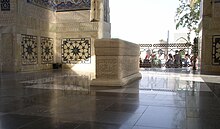al-Buchari

Muhammad ibn Ismāʿīl ibn Ibrāhīm ibn al-Mughīra al-Buchārī al-Juʿfī ,محمد بن إسماعيل بن إبراهيم بن المغيرة البخاري / Muḥammad b. Ismāʿīl b. Ibrāhīm b. al-Muġīra al-Buḫārī al-Ǧuʿfī , known from his place of birth under the name Imam al-Bukhari (born July 21, 810 in Buchārā ; died 870 in Chartang near Samarkand , today Uzbekistan ), was an important Islamic scholar.
Life
Al-Buchari came from a wealthy family. His great-great-grandfather, as al-Mizzī and adh-Dhahabī in their scholarly biographies , still bore the Persian name Ibn Badhdizbah, Var. Bardizbah in the Arabic meaning of "zarrāʿ" (farmer). His great-grandfather al-Mughīra was still a Zoroastrian and adopted Islam under the governor of Buchārā.
Al-Buchari had an Arab-Islamic education and began studying hadith and other scientific disciplines very early. At the age of 16 he went on pilgrimage with his mother and brother and then studied with scholars from Mecca and Medina . After a 16-year study trip, including in Basra , Kufa , Syria and Egypt , he returned to Nishapur . According to his own statements, he is said to have studied with over a thousand scholars of his time.
Although al-Bukhari took the official doctrine of the iniquity of the Koran, he did not transfer this theological principle to the recitation of it by humans. The recitation, the uttering of God's word by man, is created in al-Buchari's view, i.e. H. a product of man. For this reason he had to leave the city and return to Buchārā to start teaching there in the main mosque. After he did not comply with the city governor's request to give his children private lessons in his house, he was exiled to Chartank, where he spent his old age with relatives.
The Imam-al-Buchari mausoleum was built on the site of his grave in the 16th century . In 1998, a large memorial complex in honor of the Islamic scholar was completed.
Works
- al-Jamiʿ as-saheeh /الجامع الصحيح / al-Ǧāmiʿu ʾṣ-ṣaḥīḥ / 'Collection of Authentic Traditions'; The "Saheeh" is the main work of al-Bukhari, on which he is said to have worked for over sixteen years and which established his fame throughout the Islamic world. Allegedly, from 600,000 hadiths , he is said to have selected around 2,800 - without repetitions in the work - according to the strictest criteria of traditional criticism in order to include them in his collection as "Saheeh". The work ranks first of the six Sunni canonical collections of hadiths . To this day, his collection of hadiths enjoys the highest authority in Sunni Islam. It contains 97 books, which from the fourth chapter onwards are arranged thematically according to the structure of the Fiqh books ( musannaf ) and reflect the traditional religious worldview of its time. The first three chapters deal with other topics: the beginning of revelation, questions of faith, and the merits of science. They also contain traditions about the exegesis of the Koran , about good morals and dream interpretation, about the civil wars, about the merits of Muhammad's companions and about the doctrine of Tawheed .
- at-taʾrīch al-kabīr / al-awsat / as-saghīr /التأريخ الكبير, التأريخ الأوسط, التأريخ الصغير / at-taʾrīḫu ʾl-kabīr / al-awsaṭ / aṣ-saġīr . d. H. the “big” / “middle” / and “small” story are three books in which al-Buchari the “story” d. H. summarized the vitae of traditionalists and added his own opinion about their credibility as a mediator of statements of the Prophet Mohammed (see: Hadith ) and defined his own, later authoritative terminology of the critique of hadith.
- al-adab al-mufrad /الأدب المفرد / al-adabu ʾl-mufrad / 'The unique, good morals';
- This hadith collection of a total of 1322 hadiths is limited in content to traditions with moral and ethical admonitions. The author often falls back on untrustworthy and "weak" traditionalists .
- kitāb ad-duʿafāʾ /كتاب الضعفاء / kitāb aḍ-ḍuʿafāʾ / 'The book on the weak traditionarians' also called Kitāb aḍ-ḍuʿafāʾ aṣ-ṣaġīr ("The little book on weak traditionarians").
- In this collection of a total of 422 names in alphabetical order, those traditionarians are named who, according to the criteria of al-Buchari, are to be regarded as "weak", that is, unreliable narrators of hadiths. In this book, the author introduces a new terminology that he has coined: “People kept silent about him” sakatū ʿan-hu /سكتوا عنه.
It was published in India and Aleppo with the same book by an-Nasāʾī .
literature
- Ignaz Goldziher : Muhammadan Studies. Vol. II, Halle 1890, pp. 234ff, ISBN 3-487-12606-0 .
- J. Robson: al-Bu kh ārī, Muḥammad b. Ismāʿīl , in: The Encyclopaedia of Islam , New Edition, Vol. 1, Brill, Leiden 1986, pp. 1296f.
- Fuat Sezgin : History of Arabic Literature . Vol. I 115-134. Brill, Leiden 1967.
See also
Web links
- Literature by and about Al-Buchārī in the catalog of the German National Library
- Collection of Bukhari Hadith (English)
Individual evidence
- ↑ al-Mizzī: Tahḏīb al-kamāl , Volume 24, pp. 437-438 (Beirut 1992); adh-Dhahabī: Siyar aʿlām an-nubalāʾ . Volume 12, pp. 391-392. (2nd edition. Beirut 1984).
- ^ Fuat Sezgin: History of Arabic literature. Vol. 1, p. 115
- ↑ Ignaz Goldziher: On the history of the ḥanbali movements. In: Journal of the German Oriental Society (ZDMG), Volume 62 (1908). P. 7.
- ↑ Rüdiger Lohlker (ed.): Ḥadīṯstudien - The traditions of the prophet in conversation. Festschrift for Prof. Dr. Tilman Nagel . Hamburg 2009. pp. 153-162
| personal data | |
|---|---|
| SURNAME | Al-Buchari |
| ALTERNATIVE NAMES | Buchārī, Muhammad ibn Ismāʿīl ibn Ibrāhīm ibn al-Mughīra al-Juʿfī al-; Buchārī, Muhammad ibn Ismāʿīl al-; Al-Bukhari; محمد بن إسماعيل بن ابراهيم بن المغيرة البخاري (Arabic) |
| BRIEF DESCRIPTION | Islamic scholar |
| DATE OF BIRTH | July 21, 810 |
| PLACE OF BIRTH | Buchārā |
| DATE OF DEATH | 870 |
| Place of death | Chartank at Samarkand |